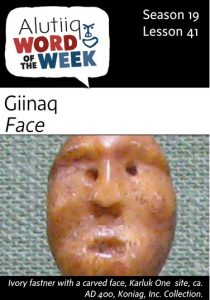 Giinaq – Face
Giinaq – Face
Giinan tang’raqa! – I see your face!
The human face is the most frequently portrayed image on Alutiiq masks. Although many masks have animal elements–a beak shaped mouth or encircling feathers for example–very few actually show complete animal faces. A rare example is an owl mask collected from an archaeological site in the village of Karluk. This unique piece may have belonged to a shaman, as the spirit helpers of shaman often appeared as owls or cranes. However, it is the human characteristics that are most evident in most masks. This pattern may reflect the Alutiiq belief that all things have a human consciousness, a person inside that could show itself and required respectful treatment. Even when animal elements are present, their use with stylized human features–a heavy brow and a long nose–suggest the underlying humanness of every being.
Like masks, the human face was also a canvas. Here, identity, emotion, and social circumstance were symbolized in classical Alutiiq society. Face paint, tattoos and jewelry were more than just decorations, they transformed a person’s image into a social statement. Mourners cut their hair and blackened their faces. Participants at winter festivals wore headdress and face paint to symbolize their home village. Girls tattooed their chins to symbolize readiness for marriage. Warriors painted their faces in preparation for a raid.
Source- Alutiiq Museum [xyz-ihs snippet=”Adsense-responsive”]
